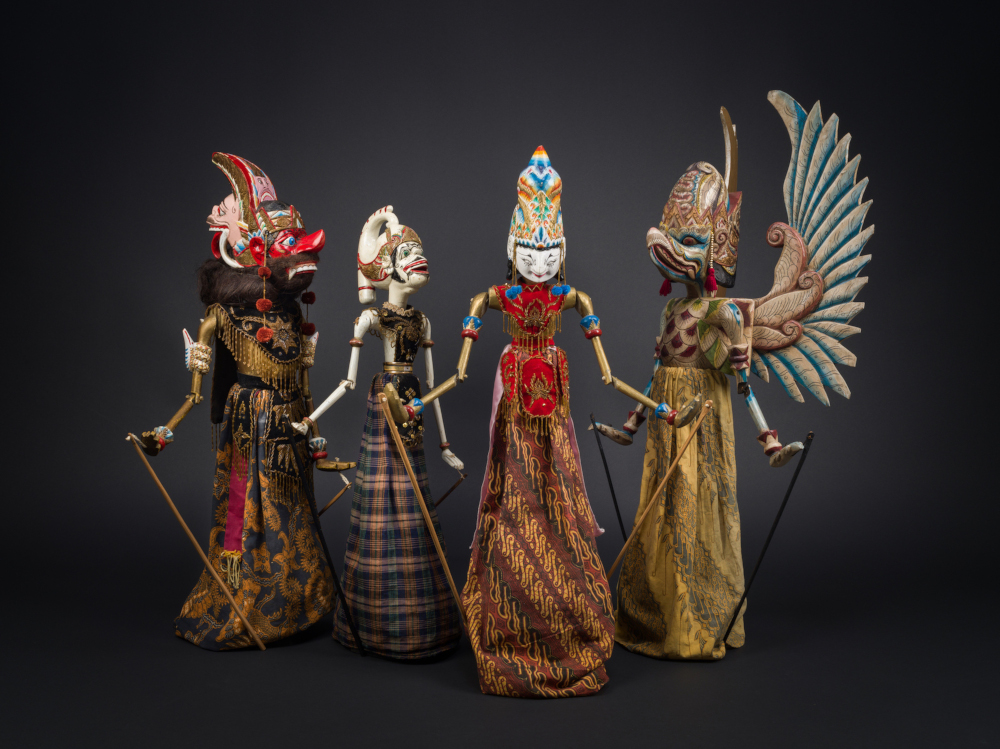The only puppet I enjoyed as a kid was Elmo, a furry red resident of Sesame Street whose voice was an octave too high and personality a little cheerful for a pessimistic child.
We tend to think of puppets as children’s entertainment or creepy villains in horror movies. But puppetry as an art form has been part of the human storytelling tradition for centuries.
The earliest historical records of puppets date back at least 2,000 years, says Nicola Levell, associate professor of anthropology at the University of British Columbia and the curator of Shadows, Strings and Other Things, an exhibition at Vancouver’s Museum of Anthropology.
This immersive new show, which runs until Oct. 14, makes ample use of the museum’s permanent collection of puppets, expanded with the help of community knowledge keepers, designers and puppet-makers.
Puppetry, says Levell, “must date back thousands and thousands of years and beyond, because it makes sense. When humans come together, they tell stories.” Shadows showcases a diverse range of puppetry traditions from across the globe, from Asia to the Americas.
The exhibition includes more than 250 puppets from 15 countries, introducing visitors to the five traditions of puppetry — hand, rod, string, shadow and stop motion. (For more detailed descriptions, check out our sidebar.)
To be honest, I had some reservations about puppets before I spoke to Levell and toured the show. I anticipated creepy objects that would haunt my dreams, a bias influenced by popular culture and demonic dolls and puppets in horror movies, such as the Puppet Master franchise.
Some puppets in the exhibition, like Gareng, a panakawan clown character from the Javanese rod puppet tradition, are deliberately unsettling. Others, such as puppets from the marionette theatre of Sicily or the Vietnamese water puppets, are beautiful.
The entrance establishes a storybook mood for the show. A pair of miniature gold hands frames a block-lettered sign with the exhibition title. Lights cast shadows of the letters, creating a seductive invitation to enter a magical space.
Levell acknowledged puppets creep some people out, and said the exhibition’s presentation aimed to make people comfortable.
“I do hope that actually visiting the exhibition, the way that they’ve been displayed and poised and lit and animated... fears will be readily dispelled,” she said. “People will just see them for what these are, these just incredibly beautiful creatures.”
I was most intrigued by Chinese shadow puppetry, known as píyĭngxì, which originated from the Han Dynasty (221 BCE to 206 CE). Shadow puppets are two-dimensional figures placed behind a screen of white cloth, with a light source that casts shadows on the screen. Puppeteers manipulate the figures to create movement. “You’ve got that strong light from behind and these figures that dance in front of these screens,” Levell says. The experience is much like watching TV, she adds.
Shadow puppetry, according to Chinese lore, was a coping mechanism for Emperor Wu after the death of his favourite concubine. Legend has it that the emperor’s advisors created the first shadow puppets to provide a version of his lost love.

A melancholic, romantic origin story can affect an audience’s interaction with puppetry. When I stood in front of the píyĭngxì — shadow puppet — stage, I was struck by the ease with which I could relate to this ancient tradition.
Grief over the loss of a loved one and the desire to see their silhouette once more are hauntingly universal. The solace Wu took from the puppets resonated through time and distance, and I felt the sensuality and profound sadness.
The exhibition’s staging helps ensure it isn’t a collection of creepy ventriloquist dolls. The displays are theatrical, and embody the lively nature of different cultural events and festivals where puppet shows usually take place.
Levell says she wanted to ensure the exhibit would celebrate wonder. “Because of the colours that they use — the glass, the light, the animation, and the sound — it is an immersive experience that doesn’t alienate, but actually enchants.”
Some puppet shows, like the Javanese shadow puppets (also known as wayang kulit) can last from midnight to dawn. Others, like the marionette theatre from Sicily, which performs Italian epics, can take a week to unfold. It’s acceptable for audience members to come and go, wandering out to visit other puppet booths, or simply taking a break to get snacks. This kind of interactivity is embedded in puppetry.

But entertainment is not the only thing that fuels people’s curiosity and interest in puppetry.
As Levell says, puppetry can be used as a “form of resistance” to respond to social justice issues, colonialism, and even intergenerational trauma.
In 1947, for example, puppetry was enlisted by the Ministry of Information in Indonesia to resist and “help dislodge the Dutch colonial regime,” said Levell.
Puppetry can also tell stories about a people, their past, and ongoing resilience in a sophisticated and poetic manner. Four Faces of the Moon, a stop-motion film featured in the exhibition, does exactly that.
Produced and directed by Amanda Strong, an Indigenous filmmaker and stop-motion director based in Vancouver, the film illustrates Canada’s darker history.
The genocide perpetrated against Indigenous peoples, as well as the residential school system, are examined through an autobiographical lens that highlights the importance of language and memory.
Puppetry is a living cultural heritage, which holds and passes on societal values. And the stories puppets tell us embody the seeds of what it means to be human. ![]()
















Tyee Commenting Guidelines
Comments that violate guidelines risk being deleted, and violations may result in a temporary or permanent user ban. Maintain the spirit of good conversation to stay in the discussion.
*Please note The Tyee is not a forum for spreading misinformation about COVID-19, denying its existence or minimizing its risk to public health.
Do:
Do not: